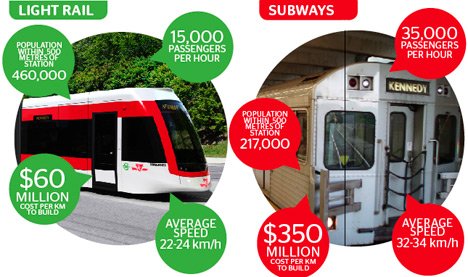
It finally happened last week – logic trumped emotion. When all the information was presented, councillors of all stripes and from all parts of the city chose light rail transit.
The February 8 transit showdown at council, which ended in a 25-to-18 vote for the most cost-effective and quickly built form of rapid transit, officially reintroduces a tweak of the Transit City plan adopted by council in 2007, and will reinstate Toronto as a public policy leader.
The only bad news is that if council had been able to challenge the mayor on cancelling Transit City (a move that contravened the spirit of the City Of Toronto Act, which says only council can direct staff), then we would have seen the opening of the Sheppard LRT to Morningside late next year. Construction actually started on October 5, 2009, and now the city will be on the hook for up to $200 million in project cancellation fees and escalation costs.
It’s true – everyone but hardcore transit advocates and urban planning experts wants subways. The problem is that they cost $350 million per kilometre (in 2014 dollars, for tunnels and stations) due to Toronto’s geology, stringent safety and building codes, high property costs, accessibility guidelines and current private sector construction wage rates.
It could be worse: New York’s Second Avenue subway is costing close to $1 billion a kilometre. It could also be better: Montreal and cities like Madrid have built subways for under $100 million per kilometre, although lower wage rates, easier geology and different building codes make valid comparisons difficult.
Light rail, defined as medium-capacity rapid transit using low-floor rail vehicles running in dedicated and separate rights-of-way, is used worldwide to provide public transportation while allowing neighbourhoods to rejuvenate. The system promotes balanced and moderate intensification of shopping areas and neighbourhoods without requiring the same densities as subways in order to be operationally cost-effective. And LRT only costs $60 to $70 million per kilometre.
If there’s any question about LRT’s suitability in Toronto’s weather context, experience from around the world should reassure us. It’s used in northern regions like Scandinavia and Russia as well as the U.S. (Minneapolis, Boston and Denver, among other cities), Estonia, Switzerland, Belgium, Germany, Austria and France, to name a few.
LRT is also used by municipalities known for their subway systems, like Hong Kong, Tokyo, Paris and London, all of which have built light rail over the last 25 years as a more affordable way to expand their network.
Some of these systems, like those in Paris and Boston, carry close to 300,000 people a day, just about a third of the entire daily volume of passengers carried by our subway system. Paris in particular has used LRT as a tool for urban redevelopment.
In the last 20 years, more than 60 North American LRT projects have been realized or initiated, and cities often cite re-energizing neighbourhoods as a prime motivator. In Canada, Vancouver, Montreal, Edmonton and Calgary are looking to light rail as a preferred choice.
Don’t confuse T.O.’s LRT plan with what you see on St. Clair or Spadina. LRTs have wider doors than streetcars, all-door boarding, more distance between stops, which speeds up the ride, and proof of payment to reduce delays, and the vehicles can control traffic lights so they’re rarely held up by reds. Longer than our current streetcars and with more seating and capacity, they’re air-conditioned and have a fully accessible low-floor design.
The network plan here calls for widening streets in most cases so there’s minimal loss of vehicular travel (partly why the plan is relatively expensive as LRT plans go). In some cases (as in the centre of the Eglinton line) the LRT will go underground to prevent loss of surface parking and car capacity.
Our vehicles will move at 22 to 24 kph, less than the subway’s average speed of 32 to 34 kph, but since the average TTC trip is just over 6 km (verses the average GO trip of 31 km), this speed difference will amount to only a few minutes per ride. In a trip from Don Mills and Eglinton to Yonge, for instance, that time gap might be only five or six minutes, hardly worth billions of dollars.
As someone who’s never owned a car, I love subways, but I’m also a frequent TTC rider in Etobicoke, along Eglinton and in Scarborough. Like many regular transit users, I’m desperate for a rapid transit network. If we finally do accomplish the Sheppard and Finch LRTs, Toronto’s northwest and northeast will finally be connected to downtown and everywhere else.
With the province’s financial commitment in hand, we can at last achieve the only realistic expansion able to meet the aim of the Official Plan that “no one should be disadvantaged getting around Toronto because they don’t own a car.”
Adam Giambrone is the former chair of the TTC.
news@nowtoronto.com












